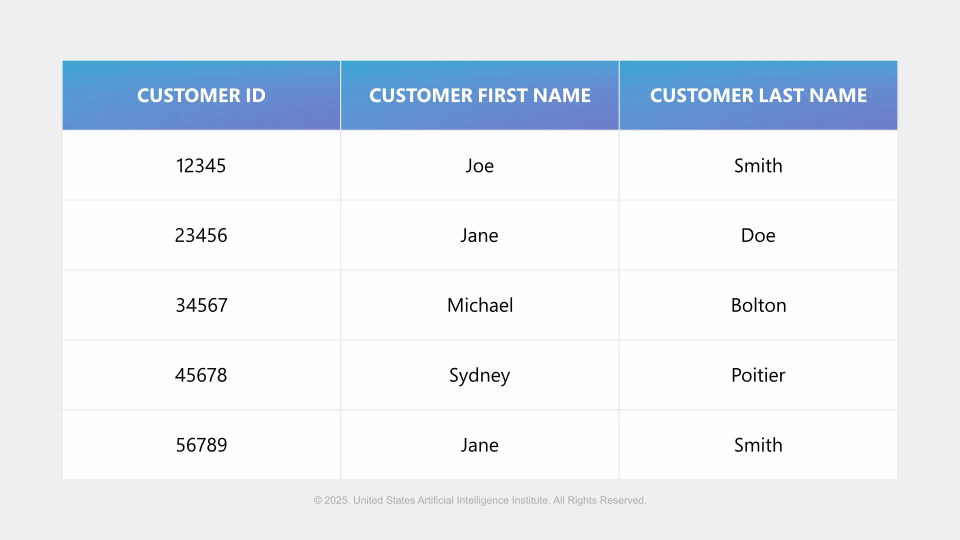
Much has been written about what Generative (Gen) AI can do, but also the nature of hallucinations which is inherent in the process. There are many tasks where Gen AI can produce different results each time it is instructed to be creative, and there are many situations where creativity is required.
There are other times when you don't want creativity, you want consistency, for example, where facts are important and need to be correct, and conventional knowledge would suggest using Traditional AI instead of Gen AI. Shumaila Handoo, Director Consulting Services - CGI, India in her article on Synergized Artificial Intelligence best stated it as follows: "Traditional AI places a stronger emphasis on effectiveness, predictability, and consistency, whereas Generative AI thrives on creativity and diversity." Although this is widely accepted to be true, there is a way of getting the best of both worlds, namely repeatable results using Gen AI: The key is to use Structured Data. For those that don’t know, structured data is data that has a specific format and structure. For example, a table in a database for customers might contain Customer Number, Customer Name, Address, etc. Each data element here can be represented in columns and rows. In contrast, unstructured data is all one stream of data. For example, text from chats is free-form (i.e. unstructured). With unstructured data, we cannot easily determine the context of the data: A name in a chat may represent a customer name or a company name.
Practical Example of using Customer Information
When working with structured data like CSV files containing customer information, generative AI models can be constrained to produce highly accurate, non-hallucinating results. For instance, consider a simple CSV file with columns for Customer ID, Customer First Name, and Customer Last Name:

When a Gen AI model is prompted to analyze this data, it can easily determine its responses directly in the structured information provided. For example, when asked "What is Jane Doe’s Customer Number?" the model can extract the precise value from the CSV rather than generating a reasonable but potentially incorrect response. Another example is if you wanted to find a list of all customers with a last name of “Smith”. This method of retrieving results enables reliable, repeatable outputs even when you give the Gen AI tool a great amount of creative freedom.
Preventing or Minimizing Hallucinations
Gen AI doesn't hallucinate when using structured data because it has a concrete, unambiguous reference point to anchor its responses. Unlike with unstructured input where the model must synthesize information from its training data—potentially introducing errors or fabrications— structured data provides an explicit ground truth against which responses can be verified.
The structured format eliminates ambiguity, providing clear parameters for what constitutes a valid response. When processing a CSV file with customer data, the model can simply retrieve the value from the appropriate row and column rather than having to generate information based on statistical patterns in its training data. This reduces the probability of hallucination to near zero when properly implemented.
Furthermore, structured data enables deterministic processing pipelines, where the conversion from raw data to final output follows clear, verifiable steps. Data in each step in this pipeline can be validated, ensuring that the final output is traceable back to source data rather than being generated through opaque statistical inference. Now that we've established how structured data grounds Gen AI, let's examine its advantages over traditional AI systems.
Advantages of Gen AI Over Traditional AI
This approach of grounding Gen AI in structured data offers several advantages over traditional AI approaches:
Disadvantages of Gen AI Over Traditional AI
Despite its advantages, using Gen AI with structured data also has limitations:
A skeptical reader might ask: "Why use Gen AI for structured data instead of traditional AI models that are purpose-built for it?" While traditional AI models excel at processing structured data, they often lack the adaptability and natural language capabilities that Gen AI provides. Gen AI allows non-technical users to interact with structured data conversationally, unlocking new ways to extract insights. In addition, the results are highly accurate.
Making Gen AI Shine with Structured Data
Despite the challenges, numerous applications stand to benefit significantly from combining Gen AI with structured data:
Conclusion
By taking advantage of Gen AI with Structured Data, we can get the best of both worlds: the usability from Gen AI combined with accurate data from the structured data. By leveraging structured data, organizations can transform Gen AI from an unpredictable creative tool into a reliable, data-driven assistant. As AI continues to evolve, this hybrid approach may set a new standard for balancing innovation with accuracy.
Follow us: